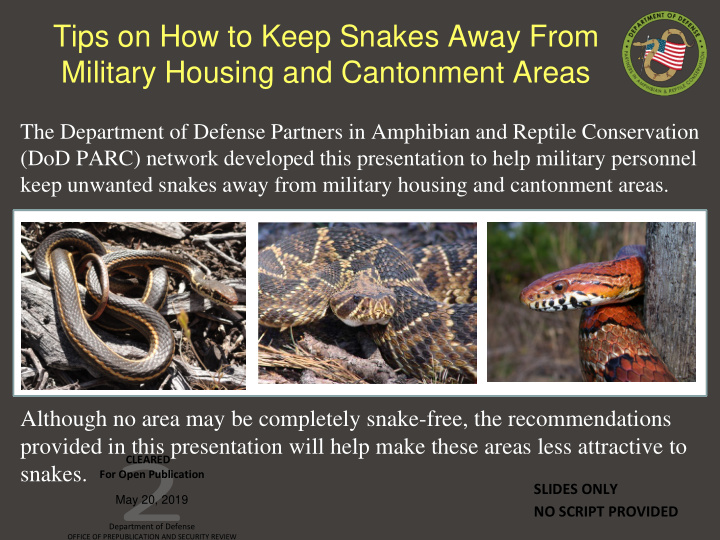



Tips on How to Keep Snakes Away From Military Housing and Cantonment Areas The Department of Defense Partners in Amphibian and Reptile Conservation (DoD PARC) network developed this presentation to help military personnel keep unwanted snakes away from military housing and cantonment areas. Although no area may be completely snake-free, the recommendations provided in this presentation will help make these areas less attractive to CLEARED snakes. For Open Publication SLIDES ONLY May 20, 2019 NO SCRIPT PROVIDED Department of Defense OFFICE OF PREPUBLICATION AND SECURITY REVIEW
Snakes and the Department of Defense • Snakes are a significant component of healthy ecosystems, serving both as predators and prey on military lands. • There are 131 snake species confirmed present on DoD installations in the continental U.S. • The North American Racer is the most common non-venomous snake confirmed present on military lands. • The Copperhead is the most common venomous snake confirmed present on military lands. Copperhead North American Racer
DoD PARC Recommendations Recommendations are divided into two categories: 1. Removing snake sheltering and hiding places around your house or work building. 2. Discouraging snake prey from around your house or work building.
Removing Sheltering and Hiding Places Around Your House or Work Building • Cut grass to a reasonable length. Snakes are cautious about traveling across short grass because it exposes them to predators. They are also easier to spot and avoid. • Regularly trim bushes and shrubs around your house / work buildings / structures (particularly on the bottom) to avoid shelter and hiding places for snakes. • Consider a gap of one to three feet between your house/building and any landscaping plants to remove the possibility of the plants providing shelter against the foundation, and to provide access for pest control.
Removing Sheltering and Hiding Places Around Your House or Work Building • Avoid using large rocks stacked on top of each other as landscaping features as these may provide crevices where snakes can hide and bask. • Keep woodpiles off the ground, as they can provide excellent hiding places for snakes. Woodpiles may also attract rodents, lizards, and other snake prey.
Removing Sheltering and Hiding Places Around Your House or Work Building • Visually inspect the foundation of your house or work building for possible snake entry points. Seal cracks or openings around air and dryer vents or other openings where a snake could get into a crawl space. • Use fencing to discourage larger snakes from entering your yard, however many species of small snakes may be able to get past this barrier. We recommend not using plastic mesh fencing, as many species of wildlife can be caught in this type of barrier. Photo by Chris Dresh Photo by Linda Harris
Discouraging Snake Prey Around Your House or Work Building Keeping snake prey (primarily rodents) away from your house or work building will help keep snakes away. We recommend the following: • Consider feeding pets indoors to avoid leaving uneaten food that attract prey of snakes, such as rodents and other small mammals. • Remove cover objects that could attract rodents to your yard such as brush piles, tin, lumber, or other discarded items (e.g., lawn mowers, cars). These objects also provide areas where snakes can hide.
Discouraging Snake Prey Around Your House or Work Building • Consider storing mulch and compost in sealed bins or containers. Unsecured piles of these materials may attract snakes. • Move bird feeders and birdhouses away from houses/buildings. Uneaten food will attract small rodents. Some species of snake are excellent climbers, and prey on eggs and nestlings of birds.
Chemical Repellents Several chemical products (usually in the form of pellets) are available at home and garden stores that you can spread around the periphery of building foundations and lawns to deter snakes from entering such areas. However, the efficacy of these materials is largely unclear, plus the chemicals may be harmful to pets and children. Please consult your installation pest management specialist before using these products.
What To Do If You See a Snake? • Leave it alone! The majority of snake bites occur when attempting to move or kill snakes. • Call your military installation property manager or natural resource manager if you need to remove a snake from a building or other area that is frequented by people. • Gently spray the snake with a garden hose (if available) to encourage it to move away. • Use a broom with a long handle to prod and encourage the snake to move away.
For More Information Visit our website: https://www.denix.osd.mil/dodparc/parc-resources/ See DoD PARC’s videos on YouTube: Snakes and Safety on Continental U.S. DoD Installations ; Venomous Snake Safety and Removal Techniques Contact the DoD PARC National Representative (chris.petersen@navy.mil) or the DoD PARC National Technical Representative (robert.lovich@navy.mil) for any questions regarding snake safety on military lands
Recommend
More recommend